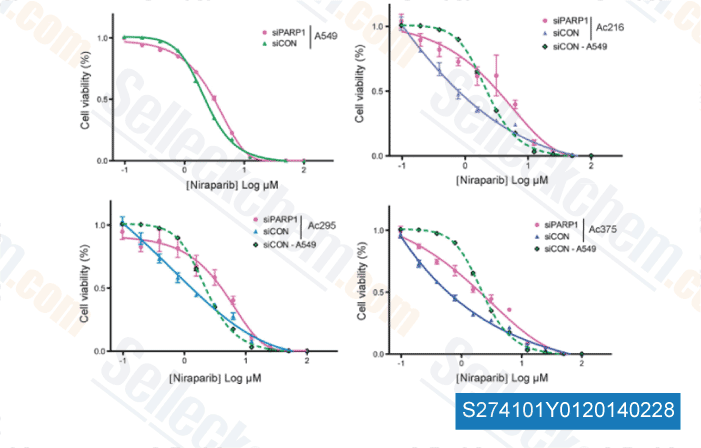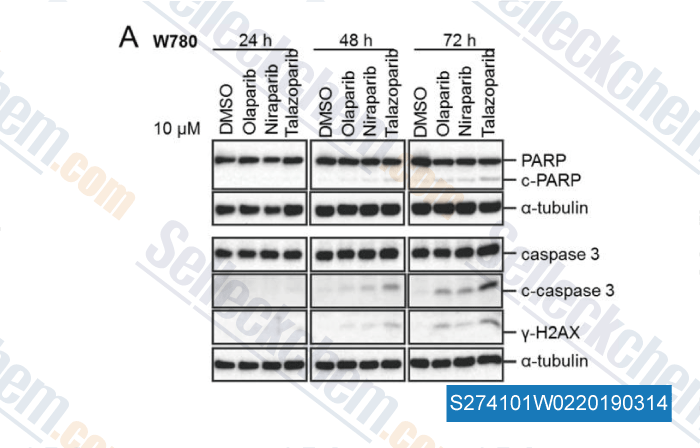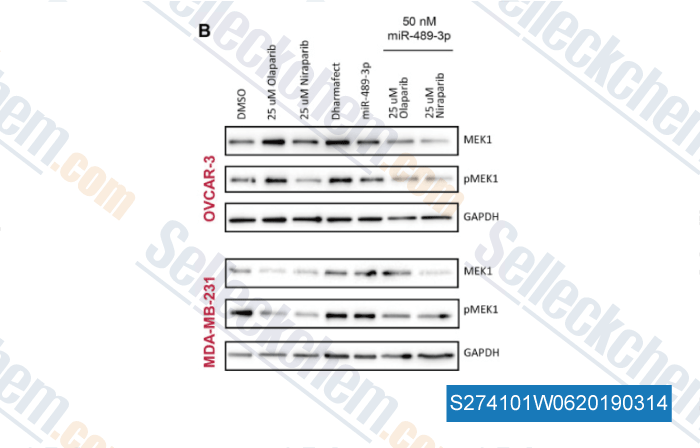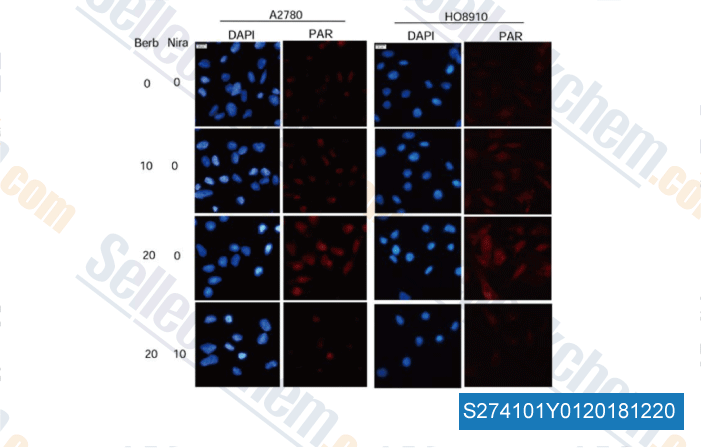|
Toll Free: (877) 796-6397 -- USA and Canada only -- |
Fax: +1-832-582-8590 Orders: +1-832-582-8158 |
Tech Support: +1-832-582-8158 Ext:3 Please provide your Order Number in the email. |
Technical Data
| Formula | C19H20N4O |
||||||
| Molecular Weight | 320.39 | CAS No. | 1038915-60-4 | ||||
| Solubility (25°C)* | In vitro | Ethanol | 64 mg/mL (199.75 mM) | ||||
| DMSO | 50 mg/mL (156.05 mM) | ||||||
| Water | Insoluble | ||||||
| In vivo (Add solvents to the product individually and in order) |
|
||||||
|
* <1 mg/ml means slightly soluble or insoluble. * Please note that Selleck tests the solubility of all compounds in-house, and the actual solubility may differ slightly from published values. This is normal and is due to slight batch-to-batch variations. * Room temperature shipping (Stability testing shows this product can be shipped without any cooling measures.) |
|||||||
Preparing Stock Solutions
Biological Activity
| Description | Niraparib (MK-4827) is a selective inhibitor of PARP1/2 with IC50 of 3.8 nM/2.1 nM, with great activity in cancer cells with mutant BRCA-1 and BRCA-2. It is >330-fold selective against PARP3, V-PARP and Tank1. Niraparib can form PARP–DNA complexes resulting in DNA damage, apoptosis, and cell death. Phase 3. | ||||
|---|---|---|---|---|---|
| Targets |
|
||||
| In vitro | In a whole cell assay, MK-4827 inhibited PARP activity with EC50 = 4 nM and inhibited proliferation of cancer cells with mutant BRCA-1 and BRCA-2 with CC50 in the 10-100 nM range. It was demonstrated to be a potent and selective PARP-1 and PARP-2 inhibitor with IC50=3.8 and 2.1 nM, respectively. Furthermore, it displayed at least a 100-fold selectivity over PARP-3, V-PARP, and tankyrase-1, with IC50 = 1300, 330, and 570 nM, respectively. As well as inhibiting the growth of HeLa cell lacking BRCA-1 because of silencing by RNA interference, MK-4827 is able to inhibit the proliferation of cancer cell lines carrying natural BRCA-1 or BRCA-2 mutations. In MDA-MB-436 human mammary gland adenocarcinoma cells carrying BRCA-1 mutations, MK-4827 displayed CC50 = 18 nM, while in CAPAN-1 human pancreatic adenocarcinoma cells, which are BRCA-2 mutant, MK-4827 displayed CC50 = 90 nM. In contrast, normal human prostate and mammary epithelial cells are resistant to MK-4827, displaying antiproliferative effects in the micromolar range, thereby demonstrating the very high selective cytotoxicity from these PARP inhibitors in BRCA-1 and -2 mutant cancer cells compared to surrounding tissue[2]. | ||||
| In vivo | MK-4827, a novel, orally bioavailable, PARP-1 and PARP-2 inhibitor, strongly enhanced the effect of radiation on a variety of human tumor xenografts, both p53 wild type and p53 mutant[1]. It was well tolerated in vivo and demonstrated efficacy as a single agent in a xenograft model of BRCA-1 deficient cancer[2]. |
Protocol (from reference)
| Cell Assay:[2] |
|
|---|---|
| Animal Study:[1] |
|
References
|
Customer Product Validation

-
Data from [Oncogene, 2013, 32(47):5377-87]

-
Data from [Data independently produced by , , Theranostics, 2017, 7(17):4340-4349]

-
Data from [Data independently produced by , , Cancer Lett, 2018, 432:84-92]

-
Data from [Data independently produced by , , Cell Death Dis, 2017, 8(10):e3070]
Selleck's Niraparib (MK-4827) has been cited by 84 publications
| Aggregability of the SQSTM1/p62-based aggresome-like induced structures determines the sensitivity to parthanatos [ Cell Death Discov, 2024, 10(1):74] | PubMed: 38346947 |
| Human Fallopian Tube-Derived Organoids with TP53 and RAD51D Mutations Recapitulate an Early Stage High-Grade Serous Ovarian Cancer Phenotype In Vitro [ Int J Mol Sci, 2024, 25(2)886] | PubMed: 38255960 |
| Repression of LSD1 potentiates homologous recombination-proficient ovarian cancer to PARP inhibitors through down-regulation of BRCA1/2 and RAD51 [ Nat Commun, 2023, 10.1038/s41467-023-42850-x] | PubMed: 37973845 |
| BRCA2 Germline Mutations Identify Gastric Cancers Responsive to PARP Inhibitors [ Cancer Res, 2023, 83(10):1699-1710] | PubMed: 37129948 |
| Unravelling homologous recombination repair deficiency and therapeutic opportunities in soft tissue and bone sarcoma [ EMBO Mol Med, 2023, e16863.] | PubMed: 36779660 |
| PARP inhibitor exerts an anti-tumor effect via LMO2 and synergizes with cisplatin in natural killer/T cell lymphoma [ BMC Med, 2023, 21(1):253] | PubMed: 37442994 |
| PARP inhibitor shuts down the global translation of thyroid cancer through promoting Pol II binding to DIMT1 pause [ Int J Biol Sci, 2023, 19(12):3970-3986] | PubMed: 37564214 |
| PBRM1 mutations might render a subtype of biliary tract cancers sensitive to drugs targeting the DNA damage repair system [ NPJ Precis Oncol, 2023, 7(1):64] | PubMed: 37400502 |
| The effect of inhibition of receptor tyrosine kinase AXL on DNA damage response in ovarian cancer [ Commun Biol, 2023, 6(1):660] | PubMed: 37349576 |
| RAD51D Secondary Mutation-Mediated Resistance to PARP-Inhibitor-Based Therapy in HGSOC [ Int J Mol Sci, 2023, 24(19)14476] | PubMed: 37833926 |
RETURN POLICY
Selleck Chemical’s Unconditional Return Policy ensures a smooth online shopping experience for our customers. If you are in any way unsatisfied with your purchase, you may return any item(s) within 7 days of receiving it. In the event of product quality issues, either protocol related or product related problems, you may return any item(s) within 365 days from the original purchase date. Please follow the instructions below when returning products.
SHIPPING AND STORAGE
Selleck products are transported at room temperature. If you receive the product at room temperature, please rest assured, the Selleck Quality Inspection Department has conducted experiments to verify that the normal temperature placement of one month will not affect the biological activity of powder products. After collecting, please store the product according to the requirements described in the datasheet. Most Selleck products are stable under the recommended conditions.
NOT FOR HUMAN, VETERINARY DIAGNOSTIC OR THERAPEUTIC USE.
